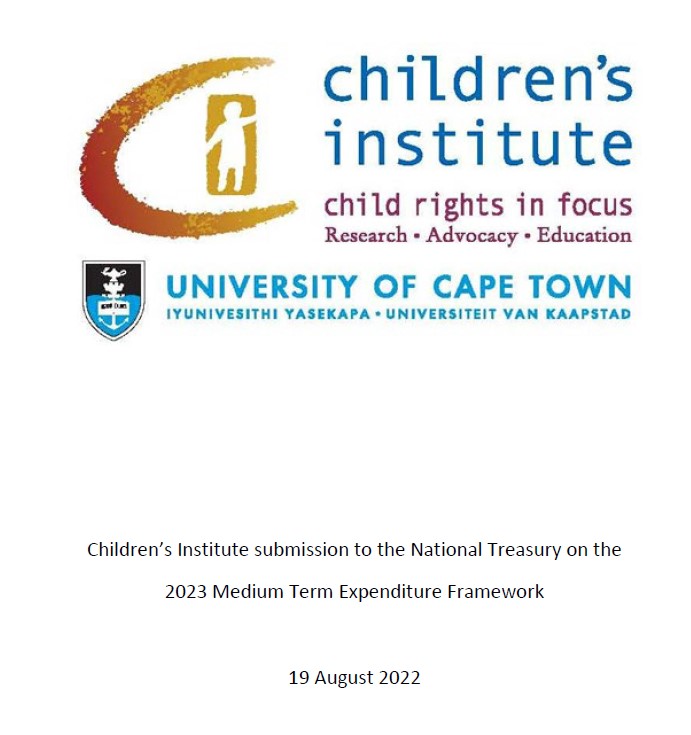Definition
This indicator shows the total number of children living in South Africa, as well as child population numbers by province, population, age group, sex, geographical area and income quintile.
Data
Source
Statistics South Africa (2003 – 2025) General Household Survey 2002 – 2024. Pretoria, Cape Town: Statistics South Africa.
Analysis by Katharine Hall & Sumaiyah Hendricks, Children’s Institute, University of Cape Town.
Analysis by Katharine Hall & Sumaiyah Hendricks, Children’s Institute, University of Cape Town.
Notes
- Children are defined as persons aged 0 – 17 years.
- Population numbers have been rounded to the nearest thousand.
What do the numbers tell us?
In 2022, South Africa’s total population was estimated at 62 million people.[1] The 2024 General Household Survey (GHS), when weighted, produced an estimate of 63 million, of whom 21 million were children under 18 years. Children make up 33% of the total population.
The distribution of children across provinces is slightly different to that of adults, with a greater share of children living in provinces with large rural populations. Together, KwaZulu-Natal, the Eastern Cape and Limpopo accommodate 45% of all children in South Africa, compared with 37% of adults. Gauteng, the smallest province in terms of physical size, has overtaken KwaZulu-Natal to become the province with the largest child population: 23% of all children in the country live in Gauteng. Gauteng also has the largest share of the adult population (29%) and the largest share of households. The child population of Gauteng has grown by 63% since 2002, making it the fastest growing province.
There have also been striking changes in other provincial child populations since 2002. The number of children living in the Eastern Cape has decreased substantially (by 14%) while the number of children living in the Western Cape has risen by 33%. North West has also seen a substantial increase of 24% in the child population since 2002. A rise in the child population is partly the result of population movement (for example, when children are part of migrant households or move to join existing urban households), and partly the result of natural population growth (new births within the province).
We can look at inequality by dividing all households into five equal groups or income quintiles, based on total income to the household (including earnings and social grants) and dividing that by the number of household members, with quintile 1 being the poorest 20% of households, quintile 2 being the next poorest and so on. Quintile 5 consists of the richest 20%, although there is substantial inequality even within this upper quintile group. Children are concentrated in poorer households, with 64% of children living in the poorest 40% of households (the poorest two quintiles), compared with 45% of adults.
The gender split is equal for children: 50% male and 50% female. In terms of the apartheid-era racial categories, 86% of children are African, 8% are Coloured, 4% White and 2% Indian.
These population estimates are based on the GHS, which is conducted annually by Statistics South Africa (Stats SA). The GHS usually collects data on about 20,000 households and over 70,000 individuals, though in 2020 and 2021 the survey was conducted telephonically with a smaller sample of just under 30,000 individuals in 9,000 households. The GHS returned to its full face-to-face sample from 2022. The population numbers derived from the survey are weighted to the mid-year population estimates using weights provided by Stats SA. Using previously weighted data (the 2013 population model), it appeared that the child population had remained fairly stable, with a marginal reduction of 0.2% in the population size between 2002 and 2015. However, there was considerable uncertainty around the official population estimates, particularly in the younger age groups.[2] In 2017, Stats SA updated the model and recalibrated the mid-year population estimates all the way back to 2002,[3] and subsequently released the data with new weights. The same population model was used to weight the data from 2018 onwards. Based on the revised weights it appears that the child population has grown by 16%, increasing from 18.1 million in 2002 to 21 million in 2024.
The 2017 mid-year population model, used for weighting the GHS data, is known to be out of date. Any population numbers derived from the GHS (including those in the table below and throughout this publication) should therefore be regarded with some caution. Indeed, there is general uncertainty about population numbers in South Africa, following a substantial under-count in the 2022 Census (especially among young children) and concerns about adjustments to correct for this.[4]
The distribution of children across provinces is slightly different to that of adults, with a greater share of children living in provinces with large rural populations. Together, KwaZulu-Natal, the Eastern Cape and Limpopo accommodate 45% of all children in South Africa, compared with 37% of adults. Gauteng, the smallest province in terms of physical size, has overtaken KwaZulu-Natal to become the province with the largest child population: 23% of all children in the country live in Gauteng. Gauteng also has the largest share of the adult population (29%) and the largest share of households. The child population of Gauteng has grown by 63% since 2002, making it the fastest growing province.
There have also been striking changes in other provincial child populations since 2002. The number of children living in the Eastern Cape has decreased substantially (by 14%) while the number of children living in the Western Cape has risen by 33%. North West has also seen a substantial increase of 24% in the child population since 2002. A rise in the child population is partly the result of population movement (for example, when children are part of migrant households or move to join existing urban households), and partly the result of natural population growth (new births within the province).
We can look at inequality by dividing all households into five equal groups or income quintiles, based on total income to the household (including earnings and social grants) and dividing that by the number of household members, with quintile 1 being the poorest 20% of households, quintile 2 being the next poorest and so on. Quintile 5 consists of the richest 20%, although there is substantial inequality even within this upper quintile group. Children are concentrated in poorer households, with 64% of children living in the poorest 40% of households (the poorest two quintiles), compared with 45% of adults.
The gender split is equal for children: 50% male and 50% female. In terms of the apartheid-era racial categories, 86% of children are African, 8% are Coloured, 4% White and 2% Indian.
These population estimates are based on the GHS, which is conducted annually by Statistics South Africa (Stats SA). The GHS usually collects data on about 20,000 households and over 70,000 individuals, though in 2020 and 2021 the survey was conducted telephonically with a smaller sample of just under 30,000 individuals in 9,000 households. The GHS returned to its full face-to-face sample from 2022. The population numbers derived from the survey are weighted to the mid-year population estimates using weights provided by Stats SA. Using previously weighted data (the 2013 population model), it appeared that the child population had remained fairly stable, with a marginal reduction of 0.2% in the population size between 2002 and 2015. However, there was considerable uncertainty around the official population estimates, particularly in the younger age groups.[2] In 2017, Stats SA updated the model and recalibrated the mid-year population estimates all the way back to 2002,[3] and subsequently released the data with new weights. The same population model was used to weight the data from 2018 onwards. Based on the revised weights it appears that the child population has grown by 16%, increasing from 18.1 million in 2002 to 21 million in 2024.
The 2017 mid-year population model, used for weighting the GHS data, is known to be out of date. Any population numbers derived from the GHS (including those in the table below and throughout this publication) should therefore be regarded with some caution. Indeed, there is general uncertainty about population numbers in South Africa, following a substantial under-count in the 2022 Census (especially among young children) and concerns about adjustments to correct for this.[4]
[1] Statistics South Africa. Mid-Year Population Estimates 2022. Pretoria: Statistics South Africa. 2022.
[2] Dorrington R. Alternative South African Mid-Year Estimates 2013. Monograph 13. University of Cape Town. 2013.
Technical notes
This indicator shows the number of children under the age of 18 years who live in South Africa. Population shares are calculated by dividing the number of children per category by the total number of children in the population.
The population numbers are drawn from the General Household Survey after person weights are applied. The person weights are calculated to yield the mid-year population estimates for each year, as estimated by Statistics South Africa.
The numbers are derived from the General Household Survey, a multi-purpose annual survey conducted by the national statistical agency, Statistics South Africa, to collect information on a range of topics from households in the country’s nine provinces.
The GHS uses a Master Sample frame which has been developed as a general-purpose household survey frame that can be used by all other Stats SA household-based surveys that have design requirements that are reasonably compatible with the GHS. The sample is drawn from Census enumeration areas using a stratified two-stage design with probability proportional to size sampling of PSUs in teh first stage, and sampling of dwelling units with systematic sampling in the second stage. The resulting sample consists of just over 20,000 households with around 70,000 individuals, and should be representative of all households in South Africa. It is also designed to be representative at provincial level and within provinces at metro/non-metro levels and three geography types (urban areas, rural areas under traditional authority, and farms).
The sample consists of households and does not cover other collective institutionalised living-quarters such as boarding schools, orphanages, students’ hostels, old-age homes, hospitals, prisons, military barracks and workers’ hostels. These exclusions probably do not have a noticeable impact on the findings in respect of children.
Changes in sample frame and stratification
Since 2014 the GHS has been based on the 2013 master sample that that is, in turn, based on information collected during the 2011 Population Census. The previous master sample for the GHS was used for the first time in 2008, and the one before that in 2004. These again differed from the master sample used in the first two years of the GHS: 2002 and 2003. Thus there have been four different sampling frames during history of the annual GHS, with the changes occurring in 2004, 2008 and 2013. In addition, there have been changes in the method of stratification over the years. These changes could compromise comparability across iterations of the survey to some extent, although it is common practice to use the GHS for longitudinal monitoring and many of the official trend analyses are drawn from this survey.
Weights
Person and household weights are provided by Stats SA and are applied in Children Count analyses to give population estimates on the indicators. The GHS weights are derived from Stats SA’s mid-year population estimates for the relevant year. The population estimates are based on a model that is revised from time to time when it is possible to calibrate the population model to Census data and larger population surveys such as the Community Survey.
In 2017, Stats SA revised its demographic model to produce a new series of mid-year population estimates and the GHS data were re-released with the revised population weights. All the Children Count indicators were re-analysed retrospectively, using the revised weights provided by Stats SA, based on the 2013 model. The estimates are therefore comparable over all years. The revised weights particularly affected estimates for the years 2002 – 2007.
The 2017 model drew on the 2011 census, along with vital registration, antenatal and other administrative data, but was a “smoothed” model that did not mimic the unusual shape of the age distribution found in the census. The results of the 2011 census were initially distrusted because it seemed to over-count children in the 0 – 4 age group and under-count children in the 4 – 14-year group. It is now thought that the fertility rates recorded in the 2011 population census may have been an accurate reflection of demopraphic trends, with an unexplained upswing in fertility around 2009 after which fertility rates declined again gradually. Similar patterns were found in the vital registration data as more births were reported retrospectively to the Department of Home Affairs, and in administrative data from schools, compiled by the Department of Basic Education. In effect, this means that there may be more children in South Africa than appear from the analyses presented in these analyses, where we have applied weights based on a model that it is now known to be inaccurate.
Stats SA has subsequently developed a new population model - the 2022 series, which provides revised mid-year population estimates back to 2002 and projected to 2032. However, the GHS series has not yet been reweighted.The population estimates in Children Count are therefore based on weights derived from outdated population model (2017). It is not yet clear when and how the population model will be revised again following the 2022 Census, as there are concerns around census under-count and plausibility of its findings.
Disaggregation
Statistics South Africa suggests caution when attempting to interpret data generated at low level disaggregation. The population estimates are benchmarked at the national level in terms of age, sex and population group while at provincial level, benchmarking is by population group only. This could mean that estimates derived from any further disaggregation of the provincial data below the population group may not be robust enough.
Reporting error
Error may be present due to the methodology used, i.e. the questionnaire is administered to only one respondent in the household who is expected to provide information about all other members of the household. Not all respondents will have accurate information about all children in the household. In instances where the respondent did not or could not provide an answer, this was recorded as “unspecified” (no response) or “don’t know” (the respondent stated that they didn’t know the answer).
For more information on the methods of the General Household Survey, see the metadata for the respective survey years, available on Nesstar or DataFirst
The population numbers are drawn from the General Household Survey after person weights are applied. The person weights are calculated to yield the mid-year population estimates for each year, as estimated by Statistics South Africa.
The numbers are derived from the General Household Survey, a multi-purpose annual survey conducted by the national statistical agency, Statistics South Africa, to collect information on a range of topics from households in the country’s nine provinces.
The GHS uses a Master Sample frame which has been developed as a general-purpose household survey frame that can be used by all other Stats SA household-based surveys that have design requirements that are reasonably compatible with the GHS. The sample is drawn from Census enumeration areas using a stratified two-stage design with probability proportional to size sampling of PSUs in teh first stage, and sampling of dwelling units with systematic sampling in the second stage. The resulting sample consists of just over 20,000 households with around 70,000 individuals, and should be representative of all households in South Africa. It is also designed to be representative at provincial level and within provinces at metro/non-metro levels and three geography types (urban areas, rural areas under traditional authority, and farms).
The sample consists of households and does not cover other collective institutionalised living-quarters such as boarding schools, orphanages, students’ hostels, old-age homes, hospitals, prisons, military barracks and workers’ hostels. These exclusions probably do not have a noticeable impact on the findings in respect of children.
Changes in sample frame and stratification
Since 2014 the GHS has been based on the 2013 master sample that that is, in turn, based on information collected during the 2011 Population Census. The previous master sample for the GHS was used for the first time in 2008, and the one before that in 2004. These again differed from the master sample used in the first two years of the GHS: 2002 and 2003. Thus there have been four different sampling frames during history of the annual GHS, with the changes occurring in 2004, 2008 and 2013. In addition, there have been changes in the method of stratification over the years. These changes could compromise comparability across iterations of the survey to some extent, although it is common practice to use the GHS for longitudinal monitoring and many of the official trend analyses are drawn from this survey.
Weights
Person and household weights are provided by Stats SA and are applied in Children Count analyses to give population estimates on the indicators. The GHS weights are derived from Stats SA’s mid-year population estimates for the relevant year. The population estimates are based on a model that is revised from time to time when it is possible to calibrate the population model to Census data and larger population surveys such as the Community Survey.
In 2017, Stats SA revised its demographic model to produce a new series of mid-year population estimates and the GHS data were re-released with the revised population weights. All the Children Count indicators were re-analysed retrospectively, using the revised weights provided by Stats SA, based on the 2013 model. The estimates are therefore comparable over all years. The revised weights particularly affected estimates for the years 2002 – 2007.
The 2017 model drew on the 2011 census, along with vital registration, antenatal and other administrative data, but was a “smoothed” model that did not mimic the unusual shape of the age distribution found in the census. The results of the 2011 census were initially distrusted because it seemed to over-count children in the 0 – 4 age group and under-count children in the 4 – 14-year group. It is now thought that the fertility rates recorded in the 2011 population census may have been an accurate reflection of demopraphic trends, with an unexplained upswing in fertility around 2009 after which fertility rates declined again gradually. Similar patterns were found in the vital registration data as more births were reported retrospectively to the Department of Home Affairs, and in administrative data from schools, compiled by the Department of Basic Education. In effect, this means that there may be more children in South Africa than appear from the analyses presented in these analyses, where we have applied weights based on a model that it is now known to be inaccurate.
Stats SA has subsequently developed a new population model - the 2022 series, which provides revised mid-year population estimates back to 2002 and projected to 2032. However, the GHS series has not yet been reweighted.The population estimates in Children Count are therefore based on weights derived from outdated population model (2017). It is not yet clear when and how the population model will be revised again following the 2022 Census, as there are concerns around census under-count and plausibility of its findings.
Disaggregation
Statistics South Africa suggests caution when attempting to interpret data generated at low level disaggregation. The population estimates are benchmarked at the national level in terms of age, sex and population group while at provincial level, benchmarking is by population group only. This could mean that estimates derived from any further disaggregation of the provincial data below the population group may not be robust enough.
Reporting error
Error may be present due to the methodology used, i.e. the questionnaire is administered to only one respondent in the household who is expected to provide information about all other members of the household. Not all respondents will have accurate information about all children in the household. In instances where the respondent did not or could not provide an answer, this was recorded as “unspecified” (no response) or “don’t know” (the respondent stated that they didn’t know the answer).
For more information on the methods of the General Household Survey, see the metadata for the respective survey years, available on Nesstar or DataFirst






 The SAECR 2024 tracks trends on the status of children under 6.
The SAECR 2024 tracks trends on the status of children under 6. 








